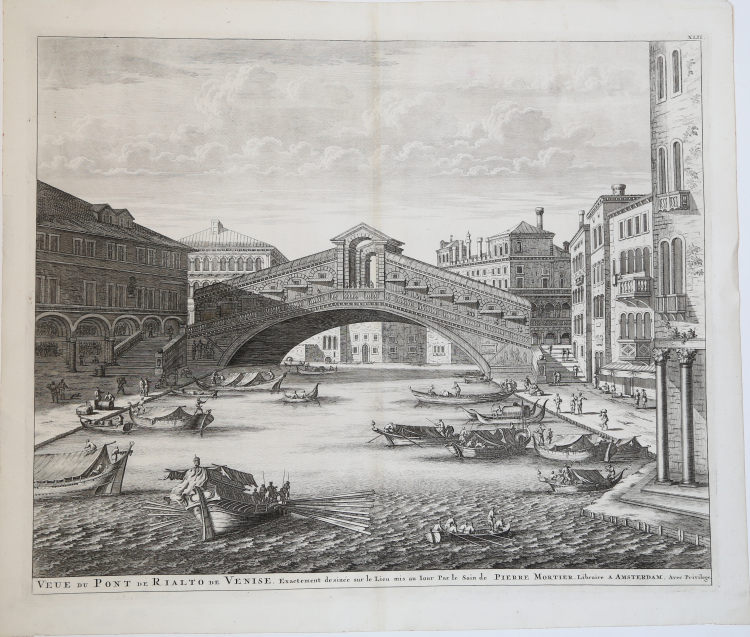




| Reference: | S90 |
| Author | Pierre MORTIER |
| Year: | 1724 |
| Zone: | Venice |
| Printed: | Amsterdam |
| Measures: | 565 x 460 mm |



| Reference: | S90 |
| Author | Pierre MORTIER |
| Year: | 1724 |
| Zone: | Venice |
| Printed: | Amsterdam |
| Measures: | 565 x 460 mm |
Spectacular view of Rialto bridge in Venice, as seen from up river.
Plate taken from the first volume of the Nouveau Theatre de l'Italie, published in Amsterdam in 1704/5 and 1724, as an addition to the project of Johannes Baleu, begun in 1663, the greatlibro delle città, lacking the plans of much of the northern part of the peninsula.
Blaeu, during his long editorial activity published three volumes on Italian cities: in 1663 the first three, divided into the State of the Church, Rome and the Kingdom of Naples and Sicily. At his death, his heirs gave birth to two more volumes, dated 1682, focused on the cities of Piedmont and Savoy, then reprinted by other publishers in 1693 and 1697. The French Pierre Mortier publishes a reprint in 1704/5, entitled Nouveau Theatre de l'Italie. The work is in four volumes and includes the plates of Blaeu, retouched and modified in small part, supplemented by the addition of several new maps of his own design, depicting the cities of the northern part of the peninsula, enclosed in the first volume of the work. Mortier's atlas was published with Latin, French and Dutch texts.
The peculiarity that differentiates the two editions of Blaeu and Mortier is represented by the fact that the text is not on the back of the single map (which is therefore white in the back), but is at the beginning of each volume. The great success of the work gave rise to a further reprint, virtually identical, edited by R. Albertsm, published in 1724/5.
Copper engraving, in good condition.
|
Cremonini pp. 83-90.
|
|
Pierre Mortier (January 26, 1661 - February 18, 1711) or Pieter Mortier was a cartographer, engraver, and print seller active in Amsterdam during the later 17th and early 18th centuries. Mortier, then known as Pieter, was born in Leiden. He relocated to Paris from 1681 to 1685, adopting the French name Pierre, which he retained throughout his career. While in France, he developed deep French connections by bringing sophisticated Dutch printing technology and experience to nascent French map publishers such as Guillaume De L'Isle (1675 - 1726), Alexis-Hubert Jaillot (c. 1632 - 1712), and Nicholas de Fer (1646 - 1720). Consequently, much of Mortier's business was built upon issuing embellished high quality editions of contemporary French maps - generally with the permissions of their original authors. In the greater context of global cartography, this was a significant advantage as most Dutch map publishes had, at this point, fallen into the miasma of reprinting their own outdated works. By contrast, the cartographers of France were producing the most accurate and up to date charts anywhere. Mortier's cartographic work culminated in the magnificent nautical atlas, Le Neptune Francois. He was awarded the Privilege, an early form of copyright, in 1690. Upon Pierre's death in 1711 this business was inherited by his widow. In 1721, his son Cornelius Mortier took over the day to day operation of the firm. Cornelius partnered with his brother-in-law Jean Covens to form one of history's great cartographic partnerships - Covens and Mortier - which continued to publish maps and atlases until about 1866.
|
|
Cremonini pp. 83-90.
|
|
Pierre Mortier (January 26, 1661 - February 18, 1711) or Pieter Mortier was a cartographer, engraver, and print seller active in Amsterdam during the later 17th and early 18th centuries. Mortier, then known as Pieter, was born in Leiden. He relocated to Paris from 1681 to 1685, adopting the French name Pierre, which he retained throughout his career. While in France, he developed deep French connections by bringing sophisticated Dutch printing technology and experience to nascent French map publishers such as Guillaume De L'Isle (1675 - 1726), Alexis-Hubert Jaillot (c. 1632 - 1712), and Nicholas de Fer (1646 - 1720). Consequently, much of Mortier's business was built upon issuing embellished high quality editions of contemporary French maps - generally with the permissions of their original authors. In the greater context of global cartography, this was a significant advantage as most Dutch map publishes had, at this point, fallen into the miasma of reprinting their own outdated works. By contrast, the cartographers of France were producing the most accurate and up to date charts anywhere. Mortier's cartographic work culminated in the magnificent nautical atlas, Le Neptune Francois. He was awarded the Privilege, an early form of copyright, in 1690. Upon Pierre's death in 1711 this business was inherited by his widow. In 1721, his son Cornelius Mortier took over the day to day operation of the firm. Cornelius partnered with his brother-in-law Jean Covens to form one of history's great cartographic partnerships - Covens and Mortier - which continued to publish maps and atlases until about 1866.
|